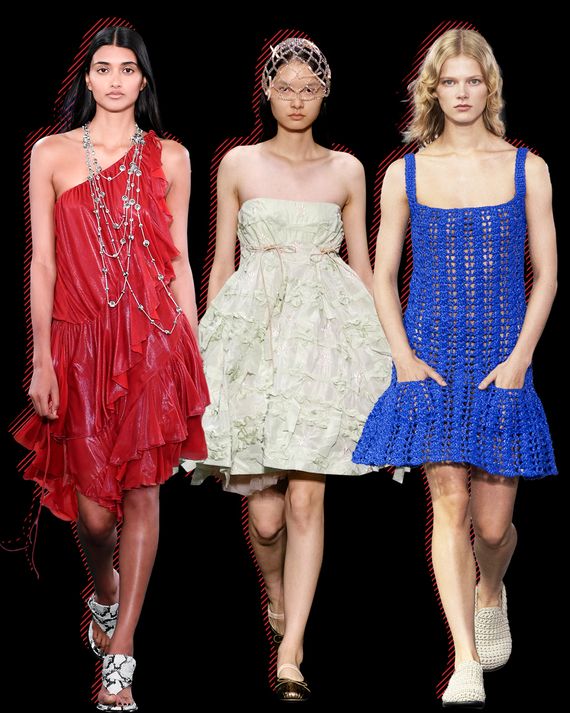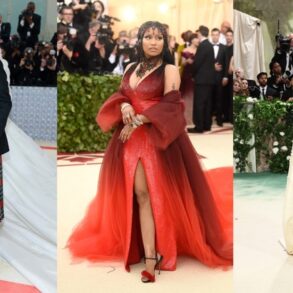
Photo-Illustration: by The Cut; Photos: Getty Images, Ben Broomfield, Jason Lloyd-Evans
At Burberry, the first major show of the European spring collections, Daniel Lee supplied a great reset on Monday. Not only did he clear away the British foul-weather jokes and acres of Burberry plaid that marked his debut in February, but he also distanced himself from the sportswear on the runways and, more conspicuously, all the body-exposing fashion.
From the first, his looks were sartorial and covered up, with the belt of simplified trench coats set on the hips for a proportion that looked new and an attitude that came off as smart yet relaxed. It’s funny how a simple adjustment of proportion on a familiar garment like the Burberry trench can make you see it anew and transform the coat to make it more interesting again.
Photo: Getty Images
In an open-air tent in Highbury Fields, the Georgian-era park in north London, Lee showed the coat in a mere handful of fabrics and colors, including black and classic tan and a black-and-white chain print. The cut of the coat changed but little because it was strong enough on its own. That was one part of his reset. Another was the silk print dress — again, in just a few breezy styles, like one-shoulder and sleeveless with a spliced, floaty hem.
Easy: Here’s your coat, which doesn’t look like a sloppy trench, and here’s a dress that works for just about any urban occasion and climate condition. He styled the looks with a variety of attractive sandals, including a stacked-heel mule with a wide triangular leather patch on top of the foot. Finally, he offered a sleeveless shirt — let’s call it an antidote to the T-shirt — in lace-cut cotton with a matching pair of boy trousers. The lace didn’t show much, but it showed enough — and that was the point. Lee seemed to assess how much exposure there is everywhere and then moved away from it.
Photo: Getty Images
The sense of a designer moving away from a consensus about fashion is what made this show so satisfying to watch. Lee sent out some novel items, like the royal-blue knitted jacket with fringe worn with white cotton trousers by the model Mona Tougaard and some bold floral looks on a black background (which he could have skipped altogether), but he had already made his case with those three elemental wardrobe statements, beginning with the trench. And the direction supplied in this show makes Burberry, and Lee, more interesting to watch in the future.
Days before the London collections opened, Sarah Burton announced she would be leaving Alexander McQueen at the end of this month, after 26 years at the house, the last 13 as creative director. Not only is Burton one of the most accomplished directors, having put her stamp on the McQueen legacy as she has extended it, but she’s also one of the few women responsible for the creative decisions of a major brand. Then, a few days later, the rising star Dilara Findikoglu, 33, whose style recalls the fierce sexiness of early McQueen and Vivienne Westwood, said she was canceling her show, claiming the expense might sink her small brand. Other designers bowed out as well, among them Christopher Kane and S.S. Daley. At a news conference, the chief executive of the British Fashion Council, Caroline Rush, said there has never been a more difficult time for independent designers.
There’s certainly a long tradition here of glory and angst on a shoestring, as a brilliant new exhibition, “Rebel: 30 Years of London Fashion” (at the Design Museum through February 11, 2024) illustrates. But this moment could also be read as a turning point, a changing of the guard in British fashion. Burton will now be free to do something on her own if she wants, to test herself in a different way. And the McQueen company will get a new point of view, a change many other brands in the past 30 years have positively realized. Lee surely understands that. Jonathan Anderson, the star at Loewe who has the talent to reinvent another brand if the opportunity arises, had a terrific show on Saturday for his own JW Anderson label. In January 2024, Simone Rocha will cross the Channel to present her haute couture collection for Jean Paul Gaultier, the first London designer — she’s Dublin-born — to be a guest designer for the couture house.
Photo: Ben Broomfield/Courtesy of Simone Rocha
Rocha, who started her business about a dozen years ago, is part of the new guard. Unlike some of her peers who do romantic — that is, very English — clothes, Rocha seems to know that life is messy and is more interesting if things feel a little off-kilter and easy to move about in. Midway into her excellent show — held in a drab rehearsal hall of the English National Ballet — a model came out in a silvery cropped motorcycle jacket, with partially exposed shoulders and a lace collar, snuggly belted over a full white lace skirt. You can imagine such a look on the street with or without the model’s brogues. Many of the fabrics had a papery texture, including ribbonlike embellishments on skirts and dresses — in white as well as pale shades of pink and pistachio — which had been pressed into flat, random creases evoking stored-away garments or linens. The collection felt more pared back for Rocha with many more straight-line styles. Last season, she tucked bundles of raffia into some of her dresses, between layers of chiffon, to evoke the harvest. This time, fresh roses were trapped in the fabric. Well, it’s spring. Customers will get silk versions.
Photo: Jason Lloyd-Evans @jasonlloydevans/Courtesy of JW Anderson
“I wanted something quite focused,” Anderson said. “Less silhouette.” Another way of understanding the difference is that his collection felt more wardrobe driven without losing the brand’s idiosyncrasies. The opening looks — hoodies with cargo shorts — were actually made of modeling clay. The “garments” were meant to evoke a tough attitude as they kind of hulked around the models’ slight frames. They were just a fascinating experiment in materials and form, something Anderson has done at Loewe, where he has worked with molded leather and combined hard materials like metal with soft fabrics.
Photo: Jason Lloyd-Evans @jasonlloydevans/Courtesy of JW Anderson
Still, he conveyed that attitude in real garments like a pair of cropped motorcycle jackets that looked almost tailored — refreshingly so — and that he paired with full-cut cargo pants. Many styles stood out, like simple, square-cut hoodie dresses in stiff canvas, mini tank dresses in a coated crochet, and the superb knitwear, notably the closing crewneck with two vertical sections of drawstrings. Yet everything held together in a relatable wardrobe with a strong sportswear vibe.
Photo: Getty Images
“I wanted to cancel the show the day before yesterday,” Paolo Carzana said after his show on Sunday night. That would have been a pity, for Carzana is a real poet. He invests his clothes, which are made mostly of cotton using natural dyes like turmeric and sandalwood, with so much heart. In short, he sees something about beauty and the body that no one else sees. The clothes, which are wrapped, knotted, and stitched in the most natural and unforced ways, look almost blown on the body. He makes other designers doing this kind of design — nominally deconstruction — look overly aggressive and not authentic.
Carzana is an artist working in a very harsh business. He told me he created his spring collection alone and then some friends and interns joined him for the last few days. “We all pulled together,” he said. “We made the shoes this morning.” They consisted of pieces of fabric laced around the models’ feet. A ballet or an opera company should think of commissioning him for costumes. He could probably use the money, and they could use his wild magic.
At London Fashion Week, a Changing of the Guard
This post was originally published on this site be sure to check out more of their content.













Leave a Comment